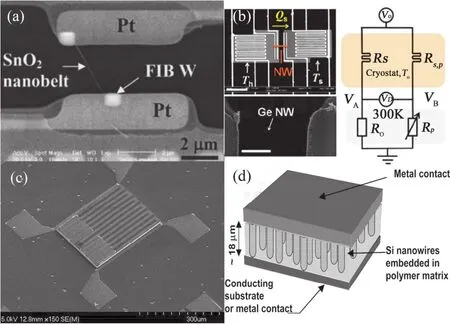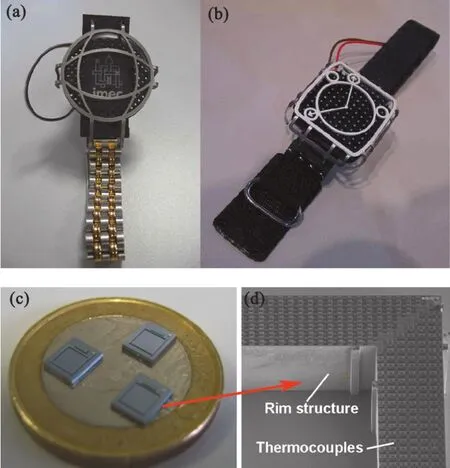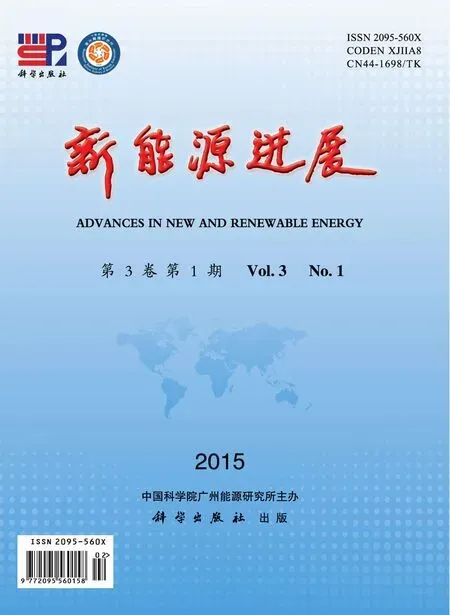纳米硅锗热电材料和纳米器件的研究进展*
2015-12-26刘呈燕杨恒全周建华
李 潮,苗 蕾,刘呈燕,杨恒全,周建华
(1. 中国科学院广州能源研究所,广州 510640;2. 中国科学院大学,北京 100049)
纳米硅锗热电材料和纳米器件的研究进展*
李 潮1,2,苗 蕾1†,刘呈燕1,杨恒全1,2,周建华1
(1. 中国科学院广州能源研究所,广州 510640;2. 中国科学院大学,北京 100049)
近年来,纳米技术逐渐被用来设计和制备硅锗(Si−Ge)热电材料和新型器件。为了提高Si−Ge热电材料的热电性能,研究学者利用各种纳米结构对Si−Ge热电材料进行了理论研究。其中,利用纳米线、超晶格和量子点等结构中的能带机理与散射机理,从理论上设计了降低Si−Ge纳米结构热导率和提高其功率因子的途径。同时,高效的Si−Ge纳米热电材料被制备出来,包括纳米块体材料的热电性能得到大幅度提高,室温下薄膜和纳米线的热电性能实现了重大突破。在高性能材料的基础上,新型Si−Ge纳米热电器件的研发除了关注于制备工艺优化外,还包括传热结构和原型器件的设计。
硅锗(Si−Ge);热电材料;纳米结构;ZT值
0 前 言
经济发展对化石燃料的巨大需求导致了化石燃料日益枯竭,并且由于化石燃料消耗引起的环境污染和全球气候变化对人类社会造成的损失日渐严重[1]。开发绿色环保以及高效的新型能源正成为科学家研究工作的重要任务之一。热电器件能将热能直接转化成电能,不需要复杂的机械结构,并且能与多种热源联用。因此,热电技术是一种无噪声、清洁和可再生的绿色新能源,具有巨大的潜在应用前景[2-4]。
热电材料利用赛贝克(Seebeck)效应将热能直 接转化成电能。当热电偶两端存在温差时,同一种载流子由于具有不同能量和存在散射等原因,造成载流子的迁移率不同而在材料两端形成电压,再与外电路连接形成电流[2,3],其产生电压的表达式如式(1)。

式中,α为Seebeck系数,Th为高温端温度,Tc为低温端温度。根据最佳使用温度范围不同可以将热电材料分为高中低温材料,其中高温热电材料以硅、锗以及Si−Ge合金材料最具代表性,通常用来高温发电。同时,热电材料可以利用帕尔贴(Peltier)效应直接将电能转化为热能用来制冷[2,3],如式(2)所示。

式中,π是Peltier系数,I是通过器件的电流强度。衡量热电材料性能的综合参数是热电优值(ZT值)[5],其表达式如式(3)。

上式中,σ为材料的电导率,λ为材料的热导率。
Si−Ge作为第IV主族元素中重要高温热电材料,具有面心立方结构和抛物线型的能带结构[6]。Si−Ge热电材料在性能方面具有高Seebeck系数和高电导率,因此具有较高的功率因子。但是由于Si−Ge具有较高的热导率,所以通常Si−Ge的ZT值不高。随着纳米技术的发展,关于Si−Ge热电材料的理论研究取得了长足的进步,其性能也获得了大幅度的提高,图1为Si−Ge热电材料ZT值的增长趋势及预测。如前所述,Si−Ge由于具有较高的热导率导致ZT值较小,因此无论从理论还是实验上的研究都是主要围绕如何有效地降低Si−Ge热导率来提高ZT值进行,同时进行新型纳米热电器件的研发。本文将从纳米技术降低Si−Ge热导率以及提高功率因子,Si−Ge纳米热电材料以及纳米器件的制备等方面对Si−Ge热电材料的研究进展进行综述。

图1 Si−Ge热电材料热电的发展趋势Fig. 1 Development of Si−Ge thermoelectric materials
1 Si−Ge热电材料理论研究
在20世纪90年代,纳米技术被认为是一种可能会显著提高热电材料性能的途径。这一预期主要是因为纳米颗粒对电子具有强的约束作用而提高功率因子,同时能增加界面对声子散射而降低晶格热导率[7-9]。热电材料的低维纳米化研究主要集中在超晶格(或超晶格量子点)薄膜材料,此外也包括纳米线、包含纳米晶粒的块体等材料[10-12]。由于Si−Ge具有较高的热导率导致其具有较低的热电性能,因此研究学者在纳米尺度下,从声子波长、色散关系和传播函数等方面提出了降低Si−Ge晶格热导率的理论和方法。
1.1 声子的空间限制与局域化
在纳米粒子中,声学声子的空间限制作用影响着它们的色散关系[13-14]。Balandin等[15]认为在设计声学声子谱的时候,首先需要获得材料在不同维度下的色散关系。在纳米尺度下,色散关系的改变会导致声学声子的群速、模式密度或声学声子与缺陷作用的方式发生改变。在纳米块体材料和薄膜材料中,色散关系的设计将强烈依靠异质材料的存在。Si−Ge超晶格材料的界面效应对于声子的限制作用很明显,Lee等[16]实验证明了13 nm Si−Ge超晶格材料具有极小的热导率,这一发现极大地刺激了研究学者对超晶格材料热导率的研究兴趣。近年来,研究学者根据空间限制和界面散射对Si−Ge超晶格、纳米线以及纳米镶嵌型块体材料进行了分析和预测。超晶格的cross-plane方向,由于异质材料的振动模式不匹配和平均自由程不匹配会引起热导率降低[17-22]。Si−Ge纳米线的色散关系不仅依赖于直径和表面粗糙度,也与Si−Ge异质结有关,即材料成分和界面状态[23-26]。此外,超晶格纳米线中异质结对声子的过滤效应也被研究来降低Si−Ge热电材料的热导率[27-29]。
光学声子的纵波与原胞中的原子振动方向是一致的,几乎不被界面改变。但是通过声子−电子之间的相互作用,电子能量的改变会传递给声子,从而改变声子的能量。异质结材料中,通过声子能量和波长的不匹配,将会使光学声子局域在一种材料中而降低光学声子进入另一种材料中的总量,使得光学声子的传导效率降低。除上述研究之外,研究学者还在设计各种新型纳米结构,例如Si−Ge核壳结构纳米线、声子门器件以及纳米多孔结构等方面做了大量工作[30-31]。
1.2 功率因子的优化
Si−Ge热电材料在没有进行掺杂的情况下,在300 K具有较大的Seebeck系数(1 100 μV/K),但具有较小的电导率。而引入掺杂后,电导率大幅度提高而Seebeck系数大幅度降低(小于300 μV/K)。因此,研究学者希望通过调控能带结构和载流子散射机理来获得较高的Seebeck系数,或在Seebeck系数不变的情况下,提高载流子的迁移率来提高电导率。
1993年,Hick等[32-33]提出了超晶格热电材料的理论模型并模拟,结果表明在超晶格材料中,由于载流子的有效质量具有各向异性以及态密度分布呈现量子化特性,因此有可能大幅度地提高热电材料的功率因子。在此基础上,Koga等[34-35]提出了Carrier-pocket模型,根据此模型,在Si−Ge超晶格材料中,由于电子结构的各向异性引起各个方向上能谷的扩展情况不同,当费米能级进入价带顶或导带底时将引起载流子迁移率的变化而提高Seebeck系数。
Si−Ge纳米线是一种有效降低热导率的方法,但是这种降低被认为具存在一个极小值,因此提高功率因子是进一步提高Si−Ge纳米线热电性能的一种重要方式。除了掺杂之外,Si−Ge纳米线的直径和生长方向为提高功率因子提供了可以调节的参数,有研究表明,纳米几何形貌对电导率的影响强于Seebeck系数的影响,而纳米线中离子散射对提高Seebeck系数起着十分重要的作用[36-37]。
Si−Ge超晶格量子点薄膜中具有大量的界面,其包含的量子点尺寸非常小,可以散射和(或)限制声子的输运而降低热导率;同时,由于量子点具有σ-态密度,能对电子产生强的局域化作用而使材料具有较大的Seebeck系数[38-39]。随着量子点尺寸的减小,能带分裂可能出现较窄的电子能带,会导致一些块体材料和其它纳米材料所没有的效应,例如自旋Seebeck效应、Fano效应和反常Fano效应等。当量子点尺寸降低到与电子波长相近时,分立的能带将符合Pauli不相容原理。当一个电子占据能带后,另一电子将无法进入量子点中,电子出现强关联性而表现为强局域化特征。Fano共振作为重要的电子关联输运效应而被应用在多量子点体系中以便提高其功率因子。量子点中的Fano共振在界面处分为两种情况,共振和非共振输运。这两种途径将因为电子迁移率的不同而提高Seebeck系数,但是由于电子的强关联性将使热导率违背Wiedemann-Franz原则而具有较低的电导率[40-41]。在室温下,双量子点的Aharonov-Bohmring环器件中,Fano共振对于材料的功率因子提高作用明显,同样,低温下反常Fano 共振也能提高功率因子,并且ZT值可能达到1[42]。
Si−Ge热电材料由于具有较高的热导率而不具备好的热电性能,但是由于其晶格结构和能带结构简单,所以是理想的理论和验证材料。各种具有纳米结构的Si−Ge热电材料被设计来降低热导率和提高功率因子,对热电材料的发展具有十分重要的意义。
2 Si−Ge纳米热电材料的制备
随着材料纳米制备技术的提高,不断有各种Si−Ge纳米结构材料被制备出来。Si−Ge热电材料的制备技术也从最初的区熔法等[43]合金制备方法发展到使用机械合金法、真空镀膜法以及金属辅助刻蚀法等。
机械合金法制备的Si−Ge热电材料由于具有纳米结构(较低的热导率)而被广泛研究。20世纪八九十年代,研究学者对Si−Ge热电材料的机械合金法工艺进行了深入的研究,包括球磨球的材质和热压温度对晶粒的影响[44-45],氧气含量对Si−Ge热电材料电学性能和传热性能的影响[46]以及重掺杂和掺杂对晶界的影响[47]。在此基础上,麻省理工学院(MIT)纳米工程团队利用高能球磨和热压技术分别合成了高掺杂的n型和p型纳米块体热电材料,如图2所示,100 nm及以下多尺寸结构的存在增加了材料中的界面排列,使得晶界对声子的散射作用增强而降低热导率;同时,在他们的系列工作中发现材料的电导率并没有随界面的增加而增加,因此获得了ZTp=1和ZTn=1.3的高性能Si−Ge热电材料[48-49]。尽管纳米尺寸界面能通过散射声学声子降低热导率,然而对于波长小于1 nm的声子可能是无效的。该课题组通过在Si中引入5%的Ge,构成点缺陷从而散射短波长的声子进一步降低热导率[50]。调制掺杂在真空镀膜中提高载流子迁移率是十分有效的,但在块体中却鲜有研究。MIT的纳米工程团队将这一概念引入到块体热电材料中,3D掺杂的块体材料中含有掺杂相和未掺杂相,如图3所示。由于未掺杂相载流子的离子散射作用几乎不存在,使得调制掺杂材料中的载流子迁移率比单一掺杂的材料有大幅度提高,进而提高了电导率和功率因子。同时,他们还调研了合金比例在调制掺杂中的作用,发现含5%的Ge对提高ZT值是最有效的[51-52]。此外,其它研究团队对重掺杂Si−Ge合金,制备工艺中的球磨条件、SPS烧结技术也做了探讨[53-54]。机械合金法制备块体Si−Ge热电材料大幅度地提高了材料的热电性能,同时很大程度上推动了Si−Ge纳米块体热电材料的理论研究。

图2 (a)n型纳米块体Si−Ge材料的TEM[48];(b)p型纳米块体Si−Ge材料的TEM[49]Fig. 2 (a) TEM of n-type nano-Si−Ge alloy[48];(b) TEM of p-type nano-Si−Ge alloy[49]

图3 (a)调制掺杂的能带原理图,n型调制掺杂的ZT值[51];(b)p型调制掺杂的功率因子,调制掺杂分布原理图[52]Fig. 3 (a) Schematic diagram of modulation doping band structure,and ZT of n-type modulation doping[51];(b) Power factor of p-type modulation doping,and Schematic diagram of particle distribution[52]
虽然薄膜材料是一类优异的热电材料,例如PbSeTe/PbTe超晶格量子点的热电性能远远超过其对应的体材料[55],但是制备热电薄膜材料的设备成本高昂,例如磁控溅射、金属有机物气相沉积(MOCVD)、等离子体增强气相沉积(PECVD)等技术,此外这类制备工艺复杂繁琐,不利于大规模应用。但是,薄膜热电器件是一种具有巨大潜在应用价值的电子器件制冷技术。现代电子工业是以硅为基础建立起来的,Si−Ge热电材料可以与电子器件直接复合实现控温器件。因此,Si−Ge热电薄膜材料的性能亟待提高。Paul团队利用MOCVD和PECVD技术制备了具有高性能Si−Ge超晶格热电材料。他们使用PECVD制备出具有不同Si−Ge比例的合金超晶格、不同厚度分布的超晶格,这些超晶格具有较大的功率因子和较低热导率,功率因子最大值可能达到6 mW/(m·K2),热导率最小值可能达到4.5 W/(m·K)[56-58]。其它结构薄膜材料的研究也取得了巨大进展[40,59-61],例如自组装Si−Ge量子点的多界面性降低热导率而提高ZT值、激光刻蚀法制备纳米尺寸的多孔Si−Ge薄膜降低热导率以及在一个量子点实现多叠层结构而大幅度降低热导率。
纳米线在一维方向由于表面粗糙导致热导率巨大降低。杨培东等[62]使用金属辅助刻蚀的方法制备具有粗糙界面的硅纳米线,直径为50 nm的Si纳米线在室温时具有较小的热导率,仅为块体硅的1/75。因此,在室温下Si纳米线具有较高的ZT值,最大可以达到0.7。同年,Boukai等[63]制备了ZT值为1的高性能纳米线,他们在SiO2上沉积掺杂了400 nm厚的Si之后,反复氧化和刻蚀获得直径为20 nm和35 nm的Si纳米线。当该纳米线处于低温时,声子−电子拖拽效应提高Si纳米线的Seebeck系数和降低热导率,从而提高了Si的热电性能。相比Si纳米线,Si−Ge纳米线或超晶格纳米线可能因合金散射等机制而具有更低的热导率,因此被用来提高Si−Ge的热电性能。同时,热电性能的提高又极大促进了纳米线器件的研究。
纳米技术在Si−Ge热电材料中的应用极大地提高了其热电性能,为高温热电器件的研发提供了可靠保证。Si−Ge热电材料应用也从单一的高温发电逐步拓展到低温制冷以及低温发电方面。
3 新型纳米器件的设计和制备
热电器件是热电材料用来发电和制冷的主要载体,热电器件的设计主要涉及材料的选取、传热结构的设计和电传导的设计。在20世纪70年代,Si−Ge热电材料已经被用于制造放射性同位素发电机,并应用于美国军用通讯卫星以及航天探测器等设备[64-65]。纳米块体热电材料可以直接利用传统的热电器件模型来制备单级或多级热电器件,尽管这种热电器件的制备是简单、可行的,然而纳米热电材料的服役性能,尤其是纳米结构的稳定性一直被人们质疑[9]。但伴随着现代电子工业的发展,更多微器件和设备被研制出来,其能源供给和制冷需求正是微电子领域急需的。因此,微能源系统和微制冷系统的研究变得举足轻重。热电材料因为能实现电和热的双向转换,所以被认为是一种具有巨大潜力的新型微能源和微制冷载体[65]。Si−Ge作为半导体工业中最重要的材料,其加工技术成熟、生产成本相对较低,而且它具有可靠性高、无毒等优势,所以Si−Ge热电材料在微型系统的研究潜力巨大,大量的新型器件正被研发。
微器件的设计通常是以IV-IV合金或V-IV合金材料为主,Si−Ge微型热电器件的设计集中于器件的几何设计和材料设计,几何设计主要涉及尺寸和传热结构对于器件的Seebeck系数、热导率和电导率等性能的影响,例如超晶格的周期尺寸对于热导率和Seebeck系数的影响。Dresselhaus及Paul等对Si−Ge薄膜器件的模型及性能进行了大量的研究。Dresslhaus等[66]设计了一种简单的Si−Ge超晶格热电器件,研究发现超晶格周期尺寸对于热电器件的性能影响较大,随着超晶格周期的减小,Si−Ge热电器件的性能提高。而Paul等利用现代微加工技术制备了Si−Ge微发电器件和微制冷器件,发现超晶格周期越短,器件的Seebeck系数越大,如图4c所示[67-68]。除了材料性能对器件的影响之外,组成微器件的热电偶对的尺寸对器件影响也十分明显,这部分工作主要以互补金属氧化物半导体(Complementary metal oxide semiconductor,COMS)结构和双极互补金属氧化物半导体(Bipolar complementary metal oxide semiconductor,BICOMS)结构为基础进行研究[69-71]。
由于Si−Ge纳米线热电材料的重大突破,Si−Ge纳米线器件也被大量研究。单根Si纳米线器件的研发,主要是以双桥器件为主,如图4a、4b所示[72-73]。双桥结构试样主要被用于测量薄膜材料及纳米线的热导率和热电性能。除了双桥器件,其它纳米线原型器件也被用来发电和制冷,如图4d所示。Abramson等[74]将Si纳米线与聚对二甲苯联合使用制备出新型Si纳米线热电器件,并通过3ω法对Si纳米线器件性能进行了测试,测试结果表明器件具有极小的热导率,而功率因子几乎维持不变。其它Si−Ge纳米线器件(如门型纳米器件等)也被设计出来[75]。

图4 (a)纳米线测试试样局部显微图[72];(b)纳米线测试试样整体图[73];(c)Si−Ge超晶格热电发电机[67];(d)直立式纳米线器件原理图[74]Fig. 4 (a) Local image of nanowires measurement device[72];(b) The overall image of nanowires measurement device[73];(c) Si−Ge superlattice generator[67];(d) Schematic diagram of vertical heat transfer nanowires device[74]
微型热电器件的研发对现代半导体工业的发展具有重要的促进作用,微型化的能源系统使得小尺寸的便携式设备更容易实现。图5所示为新型微型Si−Ge热电器件,其原理是利用人体温度去发电供给手表使用[76,77]。微型器件也可能被设计用来实现微型同位素发电机[78]。显然,越来越多的Si−Ge微型器件将具有在复杂环境下应用的潜力,这将更进一步促进Si−Ge微型热电器件的发展。

图5 (a)、(b)体温型发电机[76];(c)、(d)体温发电机微结构[77]Fig. 5 (a) and (b) body temperature thermoelectric generator[76];(c) and (d) micro-structure of body temperature thermoelectric generator[77]
4 展 望
近年来,随着纳米技术的发展,越来越来高性能的Si−Ge热电材料被设计和制备出来。从近年来Si−Ge热电材料的发展形势来看,Si−Ge热电材料的研究仍将是以纳米技术为载体来寻找降低热导率的可行性方法为主。各种纳米结构将成为Si−Ge提高热电性能的重要途径,纳米线、超晶格、超晶格量子点和纳米块体等结构中的能带机理与散射机理可能被进一步研究,用来制备热电性能更优异的Si−Ge材料。
随着Si−Ge热电材料性能的逐步提高,新型微型热电器件的研发也将成为Si−Ge热电材料的一个重要方面。
[1] Wheeler T,von Braun J. Climate change impacts on global food security[J]. Science,2013,341(6145): 508-513.
[2] Nolas G S,Sharp J,Goldsmid J. Thermoelectrics: basic principles and new materials developments[M]. Springer,2001. 1-3.
[3] MacDonald D K C. Thermoelectricity: An Introduction to the Principles[M]. New York: Wiley,1962.
[4] Riffat S B,Ma X. Thermoelectrics: a review of present and potential applications[J]. Applied Thermal Engineering,2003,23(8): 913-935.
[5] Rowe D M. Thermoelectrics,an environmentally friendly source of electrical power[J]. Renewable energy,1999,16(1): 1251-1256.
[6] 高敏,张景韶,ROWE D M. 温差电转换及其应用[M]. 北京: 兵器工业出版社,1996.
[7] Dresselhaus M S,Chen G. in Materials and Technologies for Direct Thermal-to-Electric Energy Conversion,MRS Symp.Proc. (Eds: J. Yang,T. P. Hogan,R. Funahashi,G. S. Nolas)[D]. Pittsburgh: Materials Research Society Press,2005. 3-12
[8] Dresselhaus M S,Heremans J P. Thermoelectrics Handbook: Macro to Nano (Ed: D. M. Rowe)[M]. Taylor and Francis,2006. 1-24.
[9] Dresselhaus M S,Chen G,Tang M Y,et al. New Directions for Low-Dimensional Thermoelectric Materials[J]. Advanced Materials,2007,19(8): 1043-1053.
[10] Venkatasubramanian R,Siivola E,Colpitts T,et al. Thin-film thermoelectric devices with high room-temperature figures of merit[J]. Nature,2001,413(6856): 597-602.
[11] Harman T C,Taylor P J,Walsh M P,et al. Quantum dot superlattice thermoelectric materials and devices[J]. Science,2002,297(5590): 2229-2232.
[12] Minnich A J,Dresselhaus M S,Ren Z F,et al. Bulk nanostructured thermoelectric materials: current research and future prospects[J]. Energy & Environmental Science,2009,2(5): 466-479.
[13] Balandin A,Wang K L. Significant decrease of the lattice thermal conductivity due to phonon confinement in a free-standing semiconductor quantum well[J]. Physical Review B,1998,58(3): 1544.
[14] Balandin A A. Nanophononics: Phonon engineering in nanostructures and nanodevices[J]. Journal of nanoscience and nanotechnology,2005,5(7): 1015-1022.
[15] Balandin A A,Nika D L. Phononics in low-dimensional materials[J]. Materials Today,2012,15(6): 266-275.
[16] Lee S M,Cahill D G,Venkatasubramanian R. Thermal conductivity of Si–Ge superlattices[J]. Applied physics letters,1997,70(22): 2957-2959.
[17] Borca-Tasciuc T,Liu W,Liu J,et al. Thermal conductivity of symmetrically strained Si/Ge superlattices[J]. Superlattices and Microstructures,2000,28(3): 199-206.
[18] Chen G,Neagu M. Thermal conductivity and heat transfer in superlattices[J]. Applied physics letters,1997,71(19): 2761-2763.
[19] Chen G. Thermal conductivity and ballistic-phonon transport in the cross-plane direction of superlattices[J]. Physical Review B,1998,57(23): 14958.
[20] Pokatilov E P,Nika D L,Balandin A A. A phonon depletion effect in ultrathin heterostructures with acoustically mismatched layers[J]. Applied physics letters,2004,85(5): 825-827.
[21] Aksamija Z,Knezevic I. Thermal conductivity of Si1−xGex/Si1−yGeysuperlattices: Competition between interfacial and internal scattering[J]. Physical Review B,2013,88(15): 155318.
[22] Zincenco N D,Nika D L,Pokatilov E P,et al. Acoustic phonon engineering of thermal properties of silicon-based nanostructures[C]. Journal of Physics: Conference Series. IOP Publishing,2007,92(1): 012086.
[23] Nika D L,Cocemasov A I,Crismari D V,et al. Thermal conductivity inhibition in phonon engineered core-shell cross-section modulated Si/Ge nanowires[J]. Applied Physics Letters,2013,102(21): 213109.
[24] Liu X J,Zhang G,Pei Q X,et al. Modulating the thermal conductivity of silicon nanowires via surface amorphization[J]. Science China Technological Sciences,2014,57(4): 699-705.
[25] Chen J,Zhang G,Li B. Phonon coherent resonance and its effect on thermal transport in core-shell nanowires[J]. The Journal of chemical physics,2011,135(10): 104508. [26] Chen R,Hochbaum A I,Murphy P,et al. Thermal conductance of thin silicon nanowires[J]. Physical review letters,2008,101(10): 105501.
[27] Li D,Wu Y,Fan R,et al. Thermal conductivity of Si/SiGe superlattice nanowires[J]. Applied Physics Letters,2003,83(15): 3186-3188.
[28] Lin Y M,Dresselhaus M S. Thermoelectric properties of superlattice nanowires[J]. Physical review B,2003,68(7): 075304.
[29] Dames C,Chen G. Theoretical phonon thermal conductivity of Si/Ge superlattice nanowires[J]. Journal of Applied Physics,2003,95(2): 682-693.
[30] Moon J,Kim J H,Chen Z C Y,et al. Gate-Modulated Thermoelectric Power Factor of Hole Gas in Ge–Si Core–Shell Nanowires[J]. Nano letters,2013,13(3): 1196-1202.
[31] Lee J H,Grossman J C. Thermoelectric properties of nanoporous Ge[J]. Applied Physics Letters,2009,95(1): 013106-013106-3.
[32] Hicks L D,Dresselhaus M S. Effect of quantum-well structures on the thermoelectric figure of merit[J]. Physical Review B,1993,47(19): 12727.
[33] Hicks L D,Harman T C,Sun X,et al. Experimental study of the effect of quantum-well structures on the thermoelectric figure of merit[J]. Physical Review B,1996,53(16): R10493.
[34] Koga T,Sun X,Cronin S B,et al. Carrier pocket engineering applied to “strained” Si/Ge superlattices to design useful thermoelectric materials[J]. Applied Physics Letters,1999,75(16): 2438-2440.
[35] Koga T,Sun X,Cronin S B,et al. Carrier pocket engineering to design superior thermoelectric materials using GaAs/AlAs superlattices[J]. Applied Physics Letters,1998,73(20): 2950-2952.
[36] Bahk J H,Santhanam P,Bian Z,et al. Resonant carrier scattering by core-shell nanoparticles for thermoelectric power factor enhancement[J]. Applied Physics Letters,2012,100(1): 012102.
[37] Shi L,Yao D,Zhang G,et al. Large thermoelectric figure of merit in Si1−xGexnanowires[J]. Applied Physics Letters,2010,96(17): 173108-173108-3.
[38] Liu J L,Khitun A,Wang K L,et al. Growth of Ge quantum dot superlattices for thermoelectric applications[J]. Journal of crystal growth,2001,227: 1111-1115.
[39] Khitun A,Balandin A,Liu J L,et al. In-plane lattice thermal conductivity of a quantum-dot superlattice[J]. Journal of Applied Physics,2000,88(2): 696-699.
[40] Tsaousidou M,Triberis G P. Thermoelectric properties of a weakly coupled quantum dot: Enhanced thermoelectric efficiency[J]. Journal of Physics: Condensed Matter,2010,22(35): 355304.
[41] Liu Y S,Zhang D B,Yang X F,et al. The role of Coulomb interaction in thermoelectric effects of an Aharonov–Bohm interferometer[J]. Nanotechnology,2011,22(22): 225201.
[42] Gómez-Silva G,Avalos-Ovando O,de Guevara M L L,et al. Enhancement of thermoelectric efficiency and violation of the Wiedemann-Franz law due to Fano effect[J]. Journal of Applied Physics,2012,111(5): 053704.
[43] 高敏,张景韶,电学. 温差电转换及其应用[M]. 兵器工业出版社,1996. 182-183.
[44] Cook B A,Beaudry B J,Harringa J L,et al. Thermoelectric properties of mechanically alloyed p-type Si80Ge20alloys[C]//In Proceedings of the Eighth Symposium on SpaceNuclear Power Systems,M.S. EI-Genk and M.D. Hoover,eds.,p. 431. American Institute of Physics Conference Proceedings,Part 1,New York,1991.
[45] Harringa J L,Cook B A. Application of hot isostatic pressing for consolidation of n-type silicon–germanium alloys prepared by mechanical alloying[J]. Materials Science and Engineering: B,1999,60(2): 137-142.
[46] Cook B A,Harringa J L,Han S H,et al. Parasitic effects of oxygen on the thermoelectric properties of Si80Ge20 doped with GaP and P[J]. Journal of applied physics,1992,72(4): 1423-1428.
[47] Harringa J L,Cook B A. Application of hot isostatic pressing for consolidation of n-type silicon–germanium alloys prepared by mechanical alloying[J]. Materials Science and Engineering: B,1999,60(2): 137-142.
[48] Wang X W,Lee H,Lan Y C,et al. Enhanced thermoelectric figure of merit in nanostructured n-type silicon germanium bulk alloy[J]. Applied Physics Letters,2008,93(19): 193121-193121-3
[49] Joshi G,Lee H,Lan Y,et al. Enhanced thermoelectric figure-of-merit in nanostructured p-type silicon germanium bulk alloys[J]. Nano letters,2008,8(12): 4670-4674.
[50] Zhu G H,Lee H,Lan Y C,et al. Increased phonon scattering by nanograins and point defects in nanostructured silicon with a low concentration of germanium[J]. Physical review letters,2009,102(19): 196803.
[51] Yu B,Zebarjadi M,Wang H,et al. Enhancement of thermoelectric properties by modulation-doping in silicon germanium alloy nanocomposites[J]. Nano letters,2012,12(4): 2077-2082.
[52] Zebarjadi M,Joshi G,Zhu G,et al. Power factor enhancement by modulation doping in bulk nanocomposites[J]. Nano letters,2011,11(6): 2225-2230.
[53] Zamanipour Z,Shi X,Dehkordi A M,et al. The effect of synthesis parameters on transport properties of nanostructured bulk thermoelectric p-type silicon germanium alloy[J]. Physica Status Solidi A,2012,209(10): 2049-2058.
[54] Bathula S,Jayasimhadri M,Singh N,et al. Enhanced thermoelectric figure-of-merit in spark plasma sintered nanostructured n-type SiGe alloys[J]. Applied Physics Letters,2012,101(21): 213902.
[55] Harman T C,Taylor P J,Walsh M P,et al. Quantum dot superlattice thermoelectric materials and devices[J]. Science,2002,297(5590): 2229-2232.
[56] Cecchi S,Etzelstorfer T,Müller E,et al. Ge/SiGe Superlattices for Thermoelectric Devices Grown by Low-Energy Plasma-Enhanced Chemical Vapor Deposition[J]. Journal of electronic materials,2013,42(7): 2030-2034.
[57] Llin L F,Samarelli A,Cecchi S,et al. The cross-plane thermoelectric properties of p-Ge/Si0.5Ge0.5superlattices[J]. Applied Physics Letters,2013,103(14): 143507.
[58] Samarelli A,Llin L F,Cecchi S,et al. The thermoelectric properties of Ge/SiGe modulation doped superlattices[J]. Journal of Applied Physics,2013,113(23): 233704.
[59] Stoib B,Langmann T,Petermann N,et al. Morphology,thermoelectric properties and wet-chemical doping of laser-sintered germanium nanoparticles[J]. physica status solidi (a),2013,210(1): 153-160.
[60] Stoib B,Langmann T,Matich S,et al. Laser-sintered thin films of doped SiGe nanoparticles[J]. Applied Physics Letters,2012,100(23): 231907.
[61] Chang H T,Wang C C,Hsu J C,et al. High quality multifold Ge/Si/Ge composite quantum dots for thermoelectric materials[J]. Applied Physics Letters,2013,102(10): 101902.
[62] Hochbaum A I,Chen R,Delgado R D,et al. Enhanced thermoelectric performance of rough silicon nanowires[J]. Nature,2008,451(7175): 163-167.
[63] Boukai A I,Bunimovich Y,Tahir-Kheli J,et al. Silicon nanowires as efficient thermoelectric materials[J]. Nature,2008,451(7175): 168-171.
[64] Caputo,R S,Truscello V C. Long life performance predictions of SiGe MHW-RTG multi hundred wattradioisotope thermoelectric generators[C]//8th Intersociety Energy Conversion Engineering Conference Proceedings,197. 26-30.
[65] Bottner H. Thermoelectric micro devices: current state,recent developments and future aspects for technological progress and applications[C]//In Proceedings ICT’02: Twenty-First International Conference on Thermoelectrics. 2002: 511-518.
[66] Cronin S B,Dresselhaus M S,Harman T C,et al. Si/SiGe superlattice structures for use in thermoelectric devices[P]. U.S. Patent: 6,060,656. 2000-5-9.
[67] Paul D J,Samarelli A,Llin L F,et al. Si/SiGe Thermoelectric Generators[J]. ECS Transactions,2013,50(9): 959-963.
[68] Samarelli A,Lin L F,Zhang Y,et al. Power Factor Characterization of Ge/SiGe Thermoelectric Superlattices at 300K[J]. Journal of electronic materials,2013,42(7): 1449-1453.
[69] Strasser M,Aigner R,Lauterbach C,et al. Micromachined CMOS thermoelectric generators as on-chip power supply[J]. Sensors and Actuators A: Physical,2004,114(2): 362-370.
[70] Yang S M,Cong M,Lee T. Application of quantum well-like thermocouple to thermoelectric energy harvester by BiCMOS process[J]. Sensors and Actuators A: Physical,2011,166(1): 117-124.
[71] Huesgen T,Woias P,Kockmann N. Design and fabrication of MEMS thermoelectric generators with high temperature efficiency[J]. Sensors and Actuators A: Physical,2008,145: 423-429.
[72] Shi L,Li D,Yu C,et al. Measuring thermal and thermoelectric properties of one-dimensional nanostructures using a microfabricated device[J]. Journal of heat transfer,2003,125(5): 881-888.
[73] Wingert M C,Chen Z C Y,Dechaumphai E,et al. Thermal Conductivity of Ge and Ge−Si Core−Shell Nanowires in the Phonon Confinement Regime[J]. Nano letters,2011,11(12): 5507-5513.
[74] Abramson A R,Kim W C,Huxtable S T,et al. Fabrication and characterization of a nanowire/polymer- based nanocomposite for a prototype thermoelectric device[J]. Journal of Microelectromechanical Systems,2004,13(3): 505-513.
[75] Goldberger J,Hochbaum A I,Fan R,et al. Silicon vertically integrated nanowire field effect transistors[J]. Nano letters,2006,6(5): 973-977.
[76] Leonov V,Torfs T,Fiorini P,et al. Thermoelectric converters of human warmth for self-powered wireless sensor nodes[J]. Sensors Journal,IEEE,2007,7(5): 650-657.
[77] Wang Z,Leonov V,Fiorini P,et al. Realization of a wearable miniaturized thermoelectric generator for human body applications[J]. Sensors and Actuators A: Physical,2009,156(1): 95-102.
[78] Whalen S A,Apblett C A,Aselage T L. Improving power density and efficiency of miniature radioisotopic thermoelectric generators[J]. Journal of Power Sources,2008,180(1): 657-663.
Review of Nano Si−Ge Thermoelectric Materials and Devices Research
LI Chao1,2,MIAO Lei1,LIU Cheng-yan1,YANG Heng-quan1,2,ZHOU Jian-hua1
(1. Guangzhou Institute of Energy Conversion,Chinese Academy of Sciences,Guangzhou 510640,China; 2. University of Chinese Academy of Sciences,Beijing 100049,China)
In recent years,a large number of nanotechnologies are performed to design and fabricate silicon germanium thermoelectric materials and novel devices. Band engineering and scattering mechanism theories have been taken account to theoretical design new Si−Ge nanostructures,including nanowires,superlattice and quantum dot structure,with decreasing thermal conductivity and increasing power factor. Experimentally,various Si−Ge nanostructures have been produced with improved thermoelectric performance such as nano-bulk,thin films,and nanowires. New-design thermoelectric devices not only focus on manufacture technology but also on heat transfer and novel structures.
Si−Ge;thermoelectric materials;nanostructure;ZT
TK01;TB34
A
10.3969/j.issn.2095-560X.2015.01.005
2095-560X(2015)01-0025-08
李 潮(1986-),男,硕士研究生,中国科学院广州能源所,太阳能热电系统研究,硅锗薄膜热电材料研究。
2014-05-07
2014-10-13
国家自然科学基金(51172234);广东省产学研项目(2012B091000165)
† 通信作者:苗 蕾,E-mail:miaolei@ms.giec.ac.cn
苗 蕾(1972-),女,博士,研究员,博士生导师,中国科学院“百人计划”引进国外杰出人才、中科院广州能源研究所热电转换材料与器件团队负责人、兼日本精细陶瓷研究中心材料技术研究所客座研究员,现在主要从事热电转换材料和节能方面的研究与开发工作。
